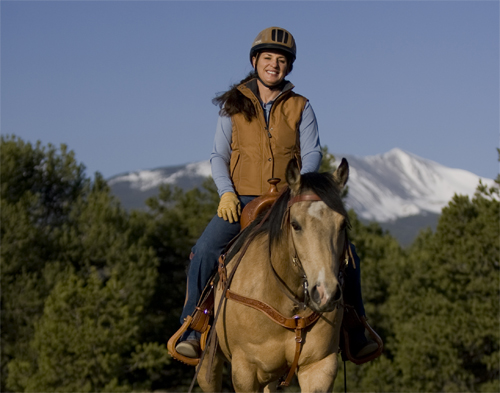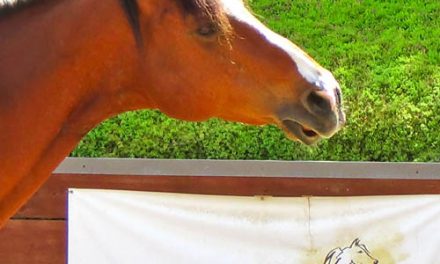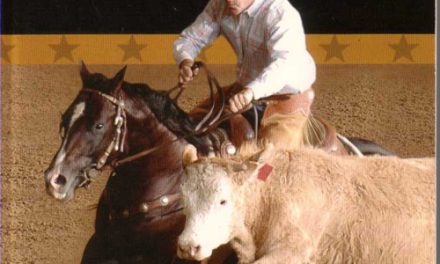Ask Julie Goodnight
 Question: Dear Julie,
Question: Dear Julie,
My 6-year-old-AQHA gelding is very focused in the arena, on or off cattle, keeping his face directed at our target or direction. On the trail, he likes to look all around and, if I don’t re-direct him, follow his face off toward whatever catches his attention. If I allow that behavior (meandering, I call it), am I creating long-term problems for us? As always, I appreciate your expertise. Thanks, Doc.
Answer: Doc,
In defense of your horse and in the spirit of “you can’t have everything,” you have to understand that a horse bred to work cattle does not always make the best trail horse. A “cowy” horse’s mind is keyed into movement and wants to follow it; he notices every little thing and tends to stay on alert. While this works out great in the arena and on cattle, it is not ideal for trail riding. Having said that, being cowy is no excuse for disobedience, and yes, if you allow disobedience, it will cause bigger problems for you down the road because it erodes your authority and leadership.
An obedient horse will be focused straight ahead and will go in the direction you ask, at the speed you dictate, without constant direction from you. Many riders micro-manage their horses by constantly steering and correcting speed with the reins, so the horse becomes dependent on that. Once you cue a horse to go at a certain speed and in a certain direction, he should continue on that path and at that speed/gait until you ask him to speed up, slow down, turn right or turn left.
To check how obedient your horse is, find a target and give him a cue to walk or trot straight toward your target, then lay your hand down on his neck with a loose rein, and see if he continues. If he changes speed or direction without a cue from you, it means you have a horse that is either disobedient or co-dependent on you and you have some work to do. You need to break your habit of micro-managing, give clear directives, then give your horse the responsibility to obey. Correct him with your reins and legs if he makes a mistake; but leave him alone when he is obedient. Use enough pressure in your corrections that he is motivated to behave.
I have written a lot about having nose control on your horse. He should not be looking around while you are riding him, either in the arena or on the trail. Simply correct the nose with the opposite rein—if he looks right, bump the left rein, and visa-versa. Do not try to hold the nose in place; just correct it when he is wrong. I use the point of shoulder as a guideline; he can move his nose all he wants as long as it stays between the points of his shoulder; as soon as it crosses the line, he gets a correction. In short order, he will keep his nose pointed in the right direction.
Keep in mind, that just because you control the nose, does not mean you control the rest of the horse. He can easily run through his shoulder and go in the opposite direction that his nose is pointed. The most important thing is to control the horse’s shoulder but if you cannot control the nose, you have little chance of controlling the rest of the body.
How strict I am on the horse’s nose and his looking around, depends somewhat on the horse, his level of training and his willingness to be obedient and subordinate. If I am riding a horse that has proven to be well-behaved, responsive and obedient, I may let him look around a little, as long as he does not alter the course I have set in either speed or direction. On the other hand, if I have a horse that has proven to be disobedient, spooky or otherwise fractious, I will have a zero tolerance for looking around.
For your cow-bred horse, you will have to factor in his training, temperament and obedience and decide how strict you will be. Always correct a horse when he changes course without a cue from you, but with a cowy horse, that is bred to be very alert to any movement in his environment, you may have to cut him a little slack as long as he remains obedient.
The most important thing for you is that you have a clear and consistent view of what will be corrected and what is expected of your horse. That’s why I use the points of shoulder as a landmark—that way I have clearly defined what I expect and I know exactly when to correct the horse and when not to, so that the horse can clearly understand the rule and that I can give consistent corrections.
You’ll have to use your own judgment with your horse, but as long as it is clear and consistent, your horse will learn quickly. Good luck!
–Julie Goodnight Trainer and Clinician
Contact:
Julie Goodnight Horsemanship Training
Goodnight Training Stables, Inc.
PO Box 397
Poncha Springs, CO 81242





